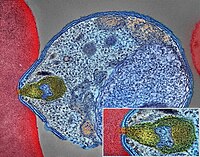
Photo from wikipedia
Background Progress towards malaria elimination has stagnated, partly because infections persisting at low parasite densities comprise a large reservoir contributing to ongoing malaria transmission and are difficult to detect. This… Click to show full abstract
Background Progress towards malaria elimination has stagnated, partly because infections persisting at low parasite densities comprise a large reservoir contributing to ongoing malaria transmission and are difficult to detect. This study compared the performance of an ultrasensitive rapid diagnostic test (uRDT) designed to detect low density infections to a conventional RDT (cRDT), expert microscopy using Giemsa-stained thick blood smears (TBS), and quantitative polymerase chain reaction (qPCR) during a controlled human malaria infection (CHMI) study conducted in malaria exposed adults (NCT03590340). Methods Blood samples were collected from healthy Equatoguineans aged 18–35 years beginning on day 8 after CHMI with 3.2 × 10 3 cryopreserved, infectious Plasmodium falciparum sporozoites (PfSPZ Challenge, strain NF54) administered by direct venous inoculation. qPCR (18s ribosomal DNA), uRDT (Alere™ Malaria Ag P.f.), cRDT [Carestart Malaria Pf/PAN (PfHRP2/pLDH)], and TBS were performed daily until the volunteer became TBS positive and treatment was administered. qPCR was the reference for the presence of Plasmodium falciparum parasites. Results 279 samples were collected from 24 participants; 123 were positive by qPCR. TBS detected 24/123 (19.5% sensitivity [95% CI 13.1–27.8%]), uRDT 21/123 (17.1% sensitivity [95% CI 11.1–25.1%]), cRDT 10/123 (8.1% sensitivity [95% CI 4.2–14.8%]); all were 100% specific and did not detect any positive samples not detected by qPCR. TBS and uRDT were more sensitive than cRDT (TBS vs. cRDT p = 0.015; uRDT vs. cRDT p = 0.053), detecting parasitaemias as low as 3.7 parasites/µL (p/µL) (TBS and uRDT) compared to 5.6 p/µL (cRDT) based on TBS density measurements. TBS, uRDT and cRDT did not detect any of the 70/123 samples positive by qPCR below 5.86 p/µL, the qPCR density corresponding to 3.7 p/µL by TBS. The median prepatent periods in days (ranges) were 14.5 (10–20), 18.0 (15–28), 18.0 (15–20) and 18.0 (16–24) for qPCR, TBS, uRDT and cRDT, respectively; qPCR detected parasitaemia significantly earlier (3.5 days) than the other tests. Conclusions TBS and uRDT had similar sensitivities, both were more sensitive than cRDT, and neither matched qPCR for detecting low density parasitaemia. uRDT could be considered an alternative to TBS in selected applications, such as CHMI or field diagnosis, where qualitative, dichotomous results for malaria infection might be sufficient.
Journal Title: Malaria Journal
Year Published: 2022
Link to full text (if available)
Share on Social Media: Sign Up to like & get
recommendations!